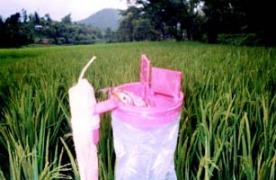Name : K. D. Kharkongor
District & State : Shillong, Meghalaya
Category : Plant varieties
Award : State
Award Function : 2nd National Grassroots Innovation Awards
Award Year : 2002
Innovation Description
 Shri K. D. Kharkongor (43 years), is an assistant agronomist in the District Agriculture Office, Ri- Bhoi district, Nongpoh. The idea for the innovation flashed into his mind when the use of Baffle traps was introduced as one of the tools of integrated pest management. The purpose was to blend the modern technology of using Baffle Traps with the indigenous practice of using dead crabs to attract insect pests from attacking standing crops. Since `Pheromone lure\’ are expensive, he thought of an alternative locally available material to replace the pheromone lure. He was aware of the widely used traditional technology of using dead crabs to attract pest of paddy crop. The encouragement and suggestion of his wife and son were very helpful all through his experiment. He says that the success of the innovation has inspired him to go further for exploring more innovations based on traditional technologies. Criticism is one thing that he openly welcomes but he despises humiliation.
Shri K. D. Kharkongor (43 years), is an assistant agronomist in the District Agriculture Office, Ri- Bhoi district, Nongpoh. The idea for the innovation flashed into his mind when the use of Baffle traps was introduced as one of the tools of integrated pest management. The purpose was to blend the modern technology of using Baffle Traps with the indigenous practice of using dead crabs to attract insect pests from attacking standing crops. Since `Pheromone lure\’ are expensive, he thought of an alternative locally available material to replace the pheromone lure. He was aware of the widely used traditional technology of using dead crabs to attract pest of paddy crop. The encouragement and suggestion of his wife and son were very helpful all through his experiment. He says that the success of the innovation has inspired him to go further for exploring more innovations based on traditional technologies. Criticism is one thing that he openly welcomes but he despises humiliation.
Rice bug (Leptocorisa sp.) is a serious pest of paddy crop. The pest attacks the standing paddy crop during the milky stage period of 10 to 15 days. Loss by this pest may go up to 70-80 per cent if left uncontrolled. It is encountered both under upland and lowland conditions in Meghalaya.
Crabs can damage the bunds by burrowing holes, thus leading to drainage of water and effecting the level of standing water in the paddy field. In fishponds also, crabs are known to cause similar damage.
Spraying or dusting of chemical insecticides before flowering usually controls the pest. But chemical pesticides also kill natural predators apart from causing other adverse side effects. There exists an age-old traditional method practiced by the farmers of Meghalaya for controlling this pest. The farmers hang dead crabs in the fields. Foul smell from these crabs attracts the pest of paddy. The bugs tend to congregate to suck the fluid and the soft rotten flesh. These bugs are then collected in a container and are destroyed before they start migrating back to the rice plants. One drawback of this method is that it calls for a constant watch. The insects need to be caught while they are feeding and many of them manage to escape.
The innovator has developed a new technique for trapping rice bugs by blending traditional knowledge of `Khasis\’ and `heli catch technique\’ developed by a private company. He has thus come up with the idea of using Baffle Traps with dead crabs to attract rice bugs instead of `Pheromone lures\’.
He first experimented in the field of Shri B. Ranee of Mawtnum village in the year 1999-2000. Dead crabs could attract both male and female rice bugs. He validated the method again in July, 2000, using four traps in the field of Shri Jiton Lyngdoh of Marngar village and six traps in the field of Shri Rishon Rympei of Umta village.
One needs minimum of four traps in one field and maximum of seven to eight traps in a field with heavy infestation. He also experimented by using intestines of chicken/goat and other materials emanating similar foul smell, in place of crab and got good success.
Using this technique, an average of 170-180 bugs per trap could be eliminated. Besides, other insects like houseflies, flying cockroaches etc., are also caught. When four dead crabs are placed in each trap, a total number of 900-1000 bugs were recorded in each trap during the entire milky stage to the grain formation stage. However, the skeletal portion left of the dried crabs are required to be replaced by fresh dead crabs after two to three days.
Government of Meghalaya has started propagating this technique within the state as a cost-effective method to trap rice bug. With the help of an NGO, `Ri-Bhoi Area Welfare Association\’, Shri Kharkongor has provided training to approximately 3000 farmers of the state.
This technique has become one of the components of Integrated Pest Management (IPM) for rice bug in the state.
http://nif.org.in/innovation/Value_addition_to_TK_for_pest_-control_in_paddy/214
